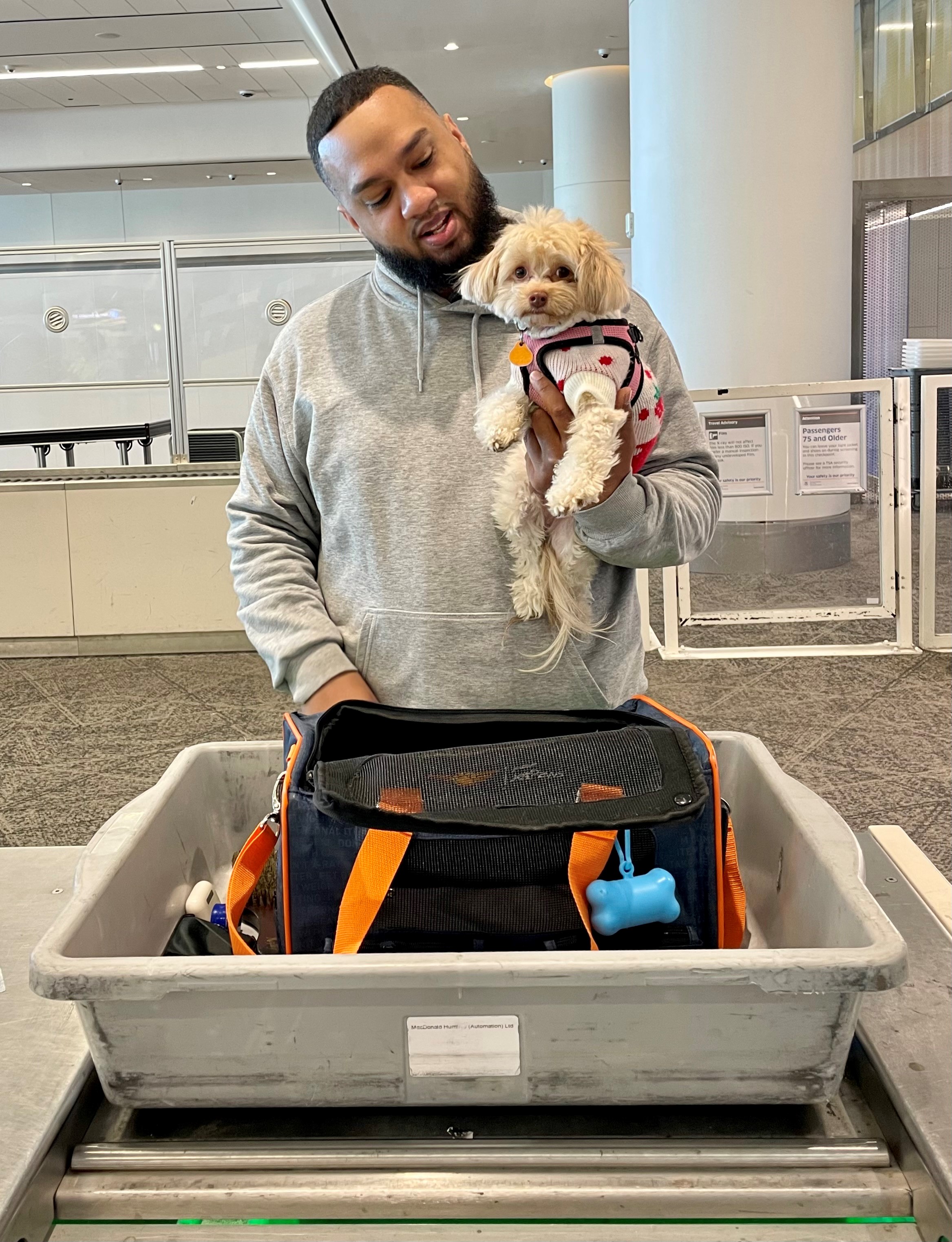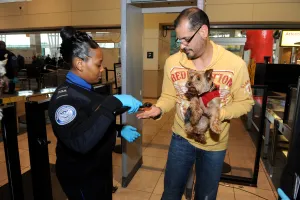 Travelers should remove pets from their travel carrier at the security checkpoint and send the carrier into the X-ray machine. Then hold their pet as they walk through the metal detector. Alternatively, the pet can be walked through the metal detector on a leash. (TSA photo)
Travelers should remove pets from their travel carrier at the security checkpoint and send the carrier into the X-ray machine. Then hold their pet as they walk through the metal detector. Alternatively, the pet can be walked through the metal detector on a leash. (TSA photo)
DULLES, Va. - Traveling through an airport security checkpoint with a pet can be easy when travelers know what to expect. Small pets can travel in the cabin of an aircraft with their owners after Transportation Security Administration (TSA) officers screen pets at the security checkpoint.
“Pets often travel with their humans and are thought of like family members,” says Scott T. Johnson, Transportation Security Administration (TSA) Federal Security Director for the airport. “That’s why it’s important that if a passenger is traveling with their pet to become familiar with the security procedures for pets and how to go through the checkpoint security screening process together quickly and easily. Key in the screening of pets is to know that they should never be screened through a checkpoint X-ray unit.”
Preparing for a pet to be screened is simple when these easy steps are followed:
- All pets should be brought to a security checkpoint in a hand-held travel carrier.
- Remove the pet from the carrier just prior to the beginning of the screening process.
- Place the empty travel carrier on the checkpoint conveyor belt so it can be X-rayed.
- Never place a pet in the X-ray tunnel. The X-ray at the security checkpoint is used to screen passengers’ personal property and carry-on luggage only.
- If possible, carry the pet through the walk-through metal detector during the screening process. Alternately, a pet can walk through the screening process if the owner has the pet on a leash. Best to listen to the guidance that a TSA officer is providing.
- A TSA officer will give the pet owner’s hands an explosive trace detection swab to ensure there is no explosive residue on the owner’s hands.
- After the screening process is complete, owners should return their pet to the travel carrier at the re-composure area away from the security checkpoint. This location helps ensure the safety of the pet as well as other passengers.
Pet travel restrictions vary by airline and airport, so it is important to check with the air carrier before traveling with a pet. Dulles International Airport has four pet relief areas, with two located outside the terminal (pre-security) and two located inside the concourses (post-security).
Other helpful travel tips to make a trip through security with a pet as easy as possible include:
- Acclimate the pet to the process of traveling by familiarizing it with the travel carrier in the days leading up to the trip. This familiarization will help ensure the pet is more relaxed as it travels through the security process and the airport.
- Be on the lookout for “working” canines and handlers at the airport. Areas where it is common to see a working dog at airports may include a security checkpoint or in the terminal concourse. If you encounter a working canine, please consider shifting to an alternate checkpoint so that there is no interference with a government working dog’s tasks.
- Know the temperament of your pet and ensure that you can maintain control of it in a busy and potentially crowded airport. This is especially important for cats, who often get skittish when they are removed from their pet carrier and hear and see the sounds and sights of a checkpoint.
- Travelers who have pets that may be skittish when removed from a pet carrier, and may attempt to struggle or jump away should request that a TSA officer screen the pet in a private screening room. The traveler will be escorted to the room with the pet still in its carrier.
- When traveling with service animals and pets, it is a good idea to contact your airline directly for policy details as they vary by airline and time of year.
- Travelers should become familiar with the pet relief areas at their departing airport and arrival airport.

